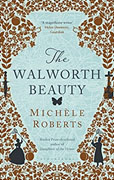The Walworth Beauty
Michele Roberts
book reviews:
· general fiction
· chick lit/romance
· sci-fi/fantasy
· graphic novels
· nonfiction
· audio books
· author interviews
· children's books @
curledupkids.com
· DVD reviews @
curledupdvd.com
newsletter
win books
buy online
links
home
for authors
& publishers
for reviewers

 |
The Walworth Beauty Michele Roberts Bloomsbury Hardcover 400 pages November 2017 |
|
While researching a book for the renowned social researcher Henry Mayhew in 1851, Joseph Benson is given the address of exotic, dark-eyed Mrs. Dulcimer. Joseph wonders how this educated and eccentric black woman--who lets her rooms to prostitutes--landed in Southwark. She pretends not to notice Joseph’s new and intense scrutiny; she tells her new admirer that girls on his side of the river, including The Haymarket, Waterloo Road and Lambeth, have indeed found a comforting home in her establishment. This is Victorian London, where you can buy any girl in a brothel or in certain lodging rooms or even rent them for the hour by discreet, “respectable-seeming landladies” who look the other way without question.
With all its talk of sex and lust and passionate yearning, the book is chastely erotic, simmering with spectral Victorian repression. Seeing the evidence of unrestrained male desire, Joseph walks the filthy streets of Southwark’s slums. He decides to compose a journalistic account, an authoritative and sober narrative of the sexual underworld, a “secret city” that will go far beyond Henry Mayhew’s requirements. It will be made up of “thumbnail histories” of the girls, exact descriptions of where they hang out and the particular services they offer. Joseph is anxious to write up his notes, pumping Mrs. Dulcimer for explanations about their jobs and their lives. In 2011 London, 60-year-old Madeleine’s parallel story sheds light on Joseph’s past. She aches to experience something new. She visits Redcross Way, a former burial ground for prostitutes where “nameless women in nameless tombs are covered by willow herb and ragwort.” This inspires her to move into a semi-basement flat in Apricot Place, Southwark, the same flat where Mrs. Dulcimer lived almost a hundred and fifty years earlier. Madeleine finds inspiration in reading Mayhew’s book, in which he talks about the angst and the realities of hard Victorian circumstances. In the process she befriends Sally, her ageless, whimsical neighbor, and Sally's daughter, Rose. The recent move, however, has aggravated Madeleine’s sense of dislocation. After going on an ill-fated date, she is haunted by sounds coming through the flat’s walls and ceilings: a baby wailing morning and night, and the mother “who tramps to and fro,” trying to silence it. Joseph is plagued by the tragedy of losing Natalie. Like Madeleine, he wanders London’s thoroughfares, embarking on the day’s business while invisible women’s skirts seem to rustle ahead of him. When he returns to the safe bosom of his home in Conduit Street, Milly welcomes him with open arms and prepares him a steaming hot bath. For the moment, at least, Joseph’s children and wife keep him healthy and happy. Joseph knows that he is vastly removed from the life of the women on the streets. He understands why these women are forced to take that first fatal step, of “crossing over from the daylight world into that other shadier one.” From their china blue eyes and lemony scent to the smell of stale sweat and rotting teeth, these “night flying prostitutes who net like moths” sell themselves as though they’re simply “pounds of butter, packets of chops, or baskets of fruit.” The reader is introduced to the poverty, filth, and "immorality,” whether the comfort of Joseph’s women or the degradation of Mayhew’s brittle Victorian landscapes, Joseph puts everything into perspective as he and Mrs. Dulcimer pass ghost-like through the squalor of time. Roberts' novel has a preternatural gravity. Similar in tone to A.S Byatt’s Possession and Michael Faber’s The Crimson Petal and the White, Roberts' lonely, aging Madeleine becomes an unexpected conduit to the shifting layers and layers of “fallen women” who lived before her, walking the streets of Apricot Place. Roberts puts an invisible sheen on this landscape where Mrs. Dulcimer tries to hide her suffering and Joseph frantically seeks to comfort her. Madeleine, on the other hand, treads through a vague terrain, finally discovering that the “lost ones” of Redcross Way are somehow still present--perhaps, in some way, still alive. Roberts fully embeds us in her colorful London settings past and present as Joseph works to expose his secret Victorian underworld, first for Mayhew and then for himself. The author’s remarkable images coax us into Joseph’s 19th-century life, a shared tribulation layered onto Madelaine’s vibrant 21st-century sensibility. Originally published on Curled Up With A Good Book at www.curledup.com. © Michael Leonard, 2017 |
| Also by Michele Roberts: |
|
|
|
 Click here to learn more about this month's sponsor! |
|
| fiction · sf/f · comic books · nonfiction · audio newsletter · free book contest · buy books online review index · links · · authors & publishers reviewers |
|
| site by ELBO Computing Resources, Inc. | |
 Roberts writes of these Victorian times in a
lush, steady stream-of-consciousness formality. With two central characters who weave in and out of each other’s lives
with ethereal ambience,
Roberts writes of these Victorian times in a
lush, steady stream-of-consciousness formality. With two central characters who weave in and out of each other’s lives
with ethereal ambience,